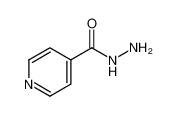
CAS No.: 54-85-3 Formula: C6H7N3O
Weight: 137.13900
Synonyms: 4-pyridinecarbohydrazide; isonicotinoyl hydrazide; Isoniazid; isonicotinic acid hydrazid; 4-pyridine-carbonic acid hydrazide; INAH; INH; Rimifon; HIA; pyridine-4-carboxylic acid hydrazide; In-73; 4-Pyridinecarboxylic acid, hydrazide; GINK; Cedin; Hyzyd;
Isoniazid, also known as isonicotinylhydrazide (INH), is an antibiotic used as a first-line agent for the prevention and treatment of both latent and active tuberculosis. It is effective against mycobacteria, particularly Mycobacterium tuberculosis. It is also active against some atypical types of mycobacteria, such as M. kansasii and M. xenopi. Isoniazid is an organic compound that is available in tablet, syrup, and injectable forms. The most common side effect of isoniazid is an increase in blood levels of liver enzymes; however, it is usually harmless. Uncommon but more serious side effects include inflammation of nerves, which causes numbness in the arms or legs, and liver inflammation. Isoniazid blocks the formation of mycolic acids, which are essential parts of mycobacterial cell walls. Disruption of the mycobacterial cell wall results in cell death. Isoniazid acts on both intracellular and extracellular mycobacteria. Isoniazid was first made in the early 20th century, but its activity against tuberculosis was first reported in the early 1950s. Three pharmaceutical companies unsuccessfully attempted to patent the drug at the same time, the most prominent one being Roche, which launched its version, Rimifon, in 1952. With the introduction of isoniazid, a cure for tuberculosis was first considered possible. It is available worldwide, is inexpensive, and is generally well tolerated. It is on the World Health Organization's List of Essential Medicines, a list of medicines that constitute the bare minimum for a basic health system.